Industry News, R&D, Pharmaceutical
Terpenes from Forests and Human Health
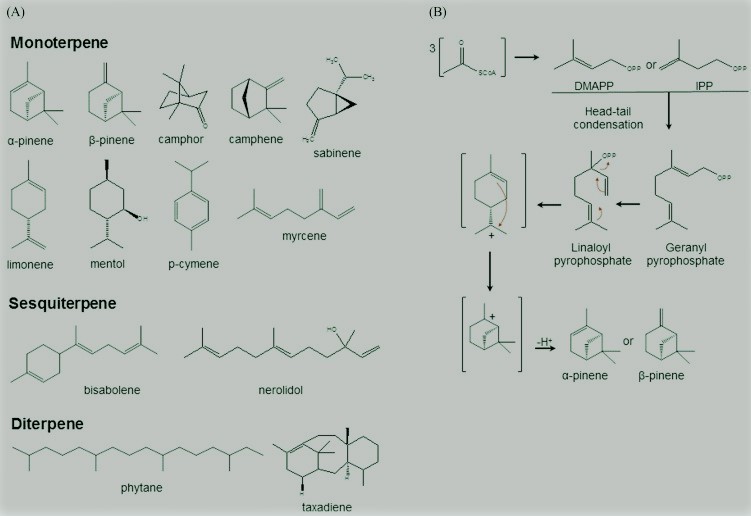
Industry News, R&D, Pharmaceutical

Forest bathing has beneficial effects on human health via showering of forest aerosols as well as physical relaxation. Terpenes that consist of multiple isoprene units are the largest class of organic compounds produced by various plants, and one of the major components of forest aerosols. Traditionally, terpene-containing plant oil has been used to treat various diseases without knowing the exact functions or the mechanisms of action of the individual bioactive compounds. This review categorizes various terpenes easily obtained from forests according to their anti-inflammatory, anti-tumorigenic, or neuroprotective activities. Moreover, potential action mechanisms of the individual terpenes and their effects on such processes, which are described in various in vivo and in vitro systems, are discussed. In conclusion, the studies that show the biological effectiveness of terpenes support the benefits of forest bathing and propose a potential use of terpenes as chemotherapeutic agents for treating various human diseases.
Keywords: Cancer, Forest therapy, Health, Immune function, Neuronal health, Terpene
Exposure to natural environment is beneficial to human health. Among environmental exposures, the effects of forest have been emphasized in many studies. Recently, it has been shown that a short trip to forest environments has therapeutic effects in children with asthma and atopic dermatitis. Based on these studies, healthcare programs to use forest have been developed in several countries. For example, in the United States, “forest recreation” became recognized as the most valuable use of forest in the 1960s in light of social welfare. In Germany, a complementary and alternative medicine practice called “Kneipp therapy” is frequently used. Kneipp therapy includes five preventive and curative methods created by Sebastian Kneipp, a German priest, in which exercise in a forest is one of the five core methods. Japan is one of the countries where the forest usage programs for human health are well developed. The Forest Agency of the Japanese government introduced the term “Shinrin-yoku,” defined as “taking in the forest atmosphere or forest bathing” in 1982, and instituted the “Therapeutic effects of forests plan” in 2005.
Many studies have shown meaningful physiological effects of forest atmosphere on people. These effects are believed to be achieved by inhaling the forest atmosphere, which includes various phytochemicals mainly produced by trees. The major components of the forest atmosphere are terpenes, which are the largest class of naturally occurring organic compounds with more than 40,000 structures reported so far. Their basic chemical structure consists of an isoprene unit (C5H8). Depending on the number of isoprene units, terpenes are classified as mono-, sesqui-, and di-terpenes (C10, C15, and C20, respectively) (Fig. 1A). Terpenes have enormous chemical structural diversity that is generated by various terpenoid metabolic pathways as well as the specialized cell types that participate in their biosynthesis. The biosynthesis of terpenes uses two common C5 building blocks, dimethylallyl pyrophosphate (DMAPP) and isopentenyl pyrophosphate (IPP), derived from acetyl coenzyme A. Head-to-tail condensation of DMAPP and IPP generates the monoterpene precursor, geranyl pyrophosphate (GPP, C10) (Fig. 1B). Furthermore, sesquiterpenes and diterpenes are created by condensation of additional IPP units to GPP (Fig. 1B).
Fig. 1
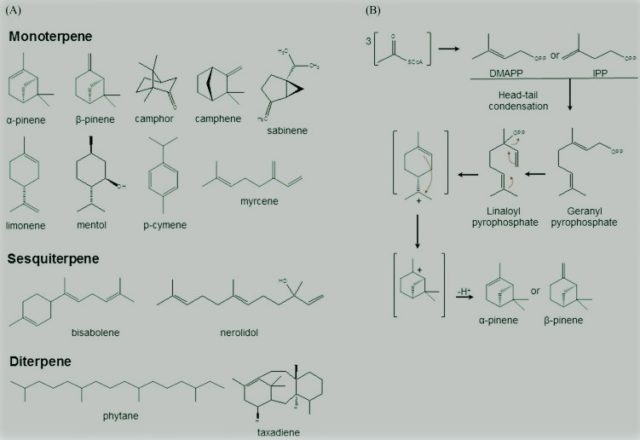
Structures of various terpenes (A) and terpene biosynthesis pathway for pinenes (B). (A) Depending on the carbon number, terpenes are classified as mono-, sesqui-, and di-terpenes. (B) Using DMAPP and IPP as building blocks, monoterpenes are produced from GPP. Especially, α-pinene and β-pinene are generated via cyclisation of linaloyl pyrophosphate and the loss of a proton from the carbocation equivalent.
Terpenes are produced by various plants, particularly conifers. Many of the terpenes are associated with not only the defense mechanism of the plant against herbivores and the environment but also their developmental physiology. forests mainly consist of various types of conifers, and many terpenes derived from them have been detected, such as α-pinene, β-pinene, camphor, camphene, sabinene, limonene, menthol, cymene, and myrcene. Conifer oleoresins contain monoterpenes (e.g., pinene and camphor) and diterpenes (e.g., taxadiene and phytane) as major components and sesquiterpenes (e.g., nerolidol and (E)-α-bisabolene) as minor components.
Given that the forest atmosphere is beneficial to human health and that terpenes are the main components of forest aerosols, we reviewed the effects of various terpenes from Korean forests on human health, especially on immunity, cancer, and neuronal health.
Studies in recent decades have demonstrated that terpenes exert anti-inflammatory effects by inhibiting various proinflammatory pathways in ear edema, bronchitis, chronic obstructive pulmonary disease, skin inflammation, and osteoarthritis.
α-Pinene, found in oils of coniferous trees and rosemary, showed anti-inflammatory activity by decreasing the activity of mitogen-activated protein kinases (MAPKs), expression of nuclear factor kappa B (NF-κB), and production of interleukin-6 (IL-6), tumor necrosis factor-α (TNF-α) and nitric oxide (NO) in lipopolysaccharide (LPS)-induced macrophages. In ovalbumin-sensitized mouse model of allergic rhinitis, pretreatment with α-pinene decreased clinical symptoms and levels of immunoglobulin E and IL-4. In human chondrocytes, α-pinene inhibited IL-1β-induced inflammation pathway by suppressing NF-κB, c-Jun N-terminal kinase (JNK) activation, and expression of iNOS and matrix metalloproteinases (MMP)-1 and -13, suggesting its role as an anti-osteoarthritic agent. Strong anti-inflammatory activity was observed when α-pinene was used in combination with two active ingredients of frankincense, linalool and 1-octanol.
Another naturally occurring monoterpene d-limonene was reported to reduce allergic lung inflammation in mice probably via its antioxidant properties. It also reduced carrageenan-induced inflammation by reducing cell migration, cytokine production, and protein extravasation. Similar to α-pinene, d-limonene exerted an anti-osteoarthritic effect by inhibiting IL-1β-induced NO production in human chondrocytes. d-Limonene treatment reduced doxorubicin-induced production of two proinflammatory cytokines, TNF-α and prostaglandin E-2 (PGE2).
Monoterpene p-cymene treatment reduced elastase-induced lung emphysema and inflammation in mice. It reduced the alveolar enlargement, number of macrophages, and levels of proinflammatory cytokines such as IL-1β, IL-6, IL-8, and IL-17 in bronchoalveolar lavage fluid (BALF). Similarly, p-cymene showed a protective effect in a mouse model of LPS-induced acute lung injury by reducing the number of inflammatory cells in the BALF and expression of NF-κB in the lungs and by reducing production of proinflammatory cytokines and infiltration of inflammatory cells. Mechanistically, p-cymene blocks NF-κB and MAPK signaling pathways. It has been reported that p-cymene reduces production of TNF-α, IL-6, and IL-β in LPS-treated RAW 264.7 macrophages. In C57BL/6 mice, TNF-α and IL-1β were downregulated and IL-10 was upregulated by p-cymene treatment. It also inhibited LPS-induced activation of ERK 1/2, p38, JNK, and IκB.
Treatment with linalool, a natural compound found in essential oils of aromatic plants, inhibited cigarette smoke-induced acute lung inflammation by inhibiting infiltration of inflammatory cells and production of TNF-α, IL-6, IL-1β, IL-8, and monocyte chemoattractant protein – 1 (MCP-1), as well as NF-κB activation. In another lung injury model, linalool attenuated lung histopathologic changes in LPS-induced mice. In in vitro experiments, linalool reduced the production of TNF-α and IL-6 and blocked phosphorylation of IκBα protein, p38, and JNK in LPS-stimulated RAW 264.7 macrophages. Similarly, linalool inhibited the production of TNF-α, IL-1β, NO, and PGE2 in LPS-stimulated microglia cells. Li et al. showed that the anti-inflammatory effect of linalool is involved in the activation of Nrf2/heme oxygenase-1 (HO-1) signaling pathway. Frankincense oil extract, which contains linalool, exhibited anti-inflammatory and analgesic effects in a xylene-induced ear edema model and a formalin-inflamed hind paw model by inhibiting COX-2.
The monoterpene γ-terpinene, present in the essential oil of many plants including Eucalyptus, reduced the acute inflammatory response. It reduced carrageenan-induced paw edema, migration of neutrophil into lung tissue, and IL-1β and TNF-α production and inhibited fluid extravasation. Terpinene-containing essential oil from Liquidambar formosana leaves reduced inflammatory response in LPS-stimulated mouse macrophages by reducing reactive oxygen species (ROS), JNK, ERK, p38 MAP kinase, and NF-κB. Another terpinene-containing essential oil from Citrus unshiu flower or fingered citron (C. medica L. var. sarcodactylis) reduced LPS-stimulated PGE2 and NO production in RAW 264.7 cells. Furthermore, production of inflammatory cytokines, such as IL-1β, TNF-α, and IL-6, was also reduced in macrophages.
Borneol, a bicyclic monoterpene present in Artemisia, Blumea, and Kaempferia, has been used in traditional medicine. Borneol alleviated acute lung inflammation by reducing inflammatory infiltration, histopathological changes, and cytokine production in LPS-stimulated mice. It suppressed phosphorylation of NF-κB, IκBα, p38, JNK, and ERK. Oral administration and intrathecal injection of borneol showed antihyperalgesic effects on inflammatory pain in complete Freund’s adjuvant-induced hypersensitive animal models by enhancing GABAAR (Gamma-Aminobutyric Acid Type A Receptor)-mediated GABAergic transmission. Borneol inhibited migration of leukocytes into the peritoneal cavity in carrageenan-stimulated mice, suggesting its anti-inflammatory function. In addition, borneol inhibited TRPA1, a cation channel that is involved in inflammation and noxious-pain sensing, suggesting that its use as an anti-inflammatory agent for neuropathic-pain and trigeminal neuralgia.
A natural sesquiterpene β-caryophyllene (BCP) was reported to protect against neuroinflammation in a rat model of Parkinson’s disease (PD) by attenuating the production of proinflammatory cytokines and inflammatory mediators such as COX-2 and iNOS. Chronic treatment with BCP attenuated alcohol-induced liver injury and inflammation by reducing the proinflammatory phenotypic switch of hepatic macrophages and neutrophil infiltration. The beneficial effects of BCP on liver injury are mediated by cannabinoid 2 (CB2) receptor activation. Prolonged administration of BCP reduced proinflammatory cytokines in pancreatic tissue of streptozotocin-induced diabetic rats. BCP reduced expression of Toll-like receptor 4 and macrophage inflammatory protein-2, and phosphorylation of ERK, p38, JNK, and NF-κB in D-galactosamine and LPS-induced liver injury mouse model.
Besides the aforementioned terpenes, anti-inflammatory effects have been reported with sabinene itself or sabinene-containing oil, bornyl acetate and myrcene.
Tumorigenesis is a multifaceted process, the progression of which is associated with several hallmarks, including uncontrolled cell growth, dysregulation of apoptosis, activation of invasion, induction of angiogenesis, and metastasis. Terpenes have been shown to exert anti-tumorigenic effects against such processes in a number of in vivo and in vitro systems, thus suggesting their potential uses as chemotherapeutic agents for treating tumors.
A number of monoterpenes have been reported to exert chemopreventive effects against tumors. Of these, the anti-tumorigenic activity of d-limonene is well-established. Numerous studies have demonstrated the protective effects of d-limonene against chemical-induced tumors in various tissue types such as breast, intestine, pancreas, liver, and colon. Lu et al. revealed that d-limonene could inhibit the proliferation of human gastric cancer cells by inducing apoptosis. Later, it was demonstrated that apoptosis of tumor cells by d-limonene could be mediated by the mitochondrial death pathway via activated caspases and PARP cleavage as well as by the suppression of the PI3K/Akt pathway. In addition, positive effects on NK (Natural Killer) activities were demonstrated not only in the in vitro treatment of tumor cell lines with monoterpenes released from trees, such as d-limonene and α-pinene, but also in forest bathing trips by increasing intracellular levels of anti-tumor proteins such as perforin, granulysin, and granzymes A/B.
Anti-tumor effects of pinenes are well established on tumor lymphocytes as well as tumor cell lines. Matsuo et al. identified the proapoptotic and anti-metastatic activities of α-pinene in a melanoma model. Later, it was revealed in human hepatoma Bel-7402 cells that the proapoptotic effect of α-pinene is associated with the induction of G2/M cell cycle arrest. In addition, α-pinene triggers oxidative stress signaling pathways in A549 and HepG2 cells. However, Kusuhara et al. reported that mice kept in a setting enriched with α-pinene showed a reduction in melanoma sizes, while in vitro treatment of melanoma cells with α-pinene had no inhibitory effect on cell proliferation, suggesting that the in vivo result may not be due to a direct effect of α-pinene. Investigation of β-pinene also revealed its cytotoxic activity against cancer and normal cell lines with a more pronounced effect on neoplastic cells in the majority of cases, showing acceptable chemotherapeutic potency.
Perillyl alcohol is a naturally occurring monoterpene, and a metabolite of limonene. Despite preclinical evidence of anticancer activity, perillyl alcohol appeared to have no clinical antitumor activity upon oral administration to patients with advanced colorectal carcinoma. However, currently, it is under preclinical development as a potential clinical treatment for patients with brain tumor. Perillic acid is a major metabolite of perillyl alcohol. Upon examining the effects of perillic acid on lung metastasis induced by melanoma cells in mice, it was observed that the administration of perillic acid remarkably reduced the metastatic tumor nodule formation by exerting an inhibitory effect on cell growth by G1 arrest.
p-Cymene has been reported to have cytotoxic effects on tumor cell lines. Recently, Li et al. evaluated beneficial effects of p-cymene on in vitro TPA-augmented invasiveness of HT-1080 cells, and found that it inhibits MMP-9 expression, but enhances TIMP-1 production along with the suppression of ERK1/2 and p38 MAPK signal pathways in tumor cells, suggesting that p-cymene is an effective candidate for the prevention of tumor invasion and metastasis.
Myrcene, the acyclic monoterpene, also exhibits significant antiproliferative and cytotoxic effects in various tumor cell lines such as MCF-7 (breast carcinoma), HeLa (human cervical carcinoma), A549 (human lung carcinoma), HT-29 (human colon adenocarcinoma), P388 (leukemia), and Vero (monkey kidney) as well as mouse macrophages. Essential oil from Vepris macrophylla demonstrated a strong cytotoxic effect, suggesting that the effect may be attributed to the presence of specific components, among which is myrcene.
Terpenes with more complex structures than monoterpenes, including sesquiterpenoids derived from sesquiterpenes by biochemical modifications, have demonstrated anticancer ability as well. The anticancer effect of various sesquiterpenoids is mediated via inhibition of inflammatory responses, prevention of metastasis, and induction of apoptosis. α-Caryophyllene, known as humulene, is a naturally occurring monocyclic sesquiterpene. BCP, an isomer of α-caryophyllene, has been identified as an active component of an essential oil mixture that not only prevents solid tumor growth and proliferation of cancer cell lines but also inhibits lymph node metastasis of melanoma cells in high-fat diet-induced obese mice. Sarvmeili et al. reported that Pinus eldarica essential oil, of which BCP was the major component, exerts cytotoxic effects on HeLa and MCF-7 cell lines.
As described above, numerous in vitro and in vivo experimental results have demonstrated that the toxicity of terpene affects mainly cancer cells without harming healthy ones, confirming their efficiency in chemotherapeutic treatment of cancer. Thus, it is noteworthy that the use of terpene and its derivatives can be considered to potentiate the action of existing conventional therapies.
Numerous studies have shown that essential oils derived from various plants have neuroprotective effects against neurodegenerative conditions in vivo and in vitro. Therefore, as the main component of plant essential oils, terpenes may be beneficial to human neuronal health. However, only few studies have focused on the beneficial effects of terpene components of plant essential oils on neuronal health.
So far, several terpenes, produced by a variety of plants, have been associated with neuronal health. Among those, borneol is a bicyclic monoterpene present in several medicinal plants. Previous studies showed that borneol has free radical scavenging activity and is a major component of essential oil of SuHeXiang Wan whose neuroprotective function has been reported in in vivo and in vitro models of Alzheimer’s disease (AD). Moreover, a recent study showed that borneol exerts a neuroprotective effect against β-amyloid (Aβ) cytotoxicity via upregulation of nuclear translocation of Nrf2 and expression of Bcl-2. In addition, treatment with isoborneol, monoterpenoid alcohol, significantly reduced 6-hydroxydopamine-induced ROS generation and cell death in human neuroblastoma SH-SY5Y cells, suggesting that isoborneol may be a potential therapeutic agent for treatment of neurodegenerative diseases associated with oxidative stress. Salvianic borneol ester, a new compound synthesized from salvianic acid A and borneol, also exerts anti-amyloid and neuroprotective effects in both SH-SY5Y cells and motor neuron hybridoma VSC 4.1 cells.
BCP also has neuroprotective functions. It has been reported that BCP has antioxidant effects, and functions as a regulator of several neuronal receptors and shows various pharmacological activities including neuroprotection. Neuroprotective effects of BCP have been reported in both AD and PD animal models. Oral treatment with BCP prevented AD-like phenotype such as cognitive impairment and activation of inflammation through CB2 receptor activation and the PPARγ pathway. As described above, BCP administration also exerts neuroprotective effects in rotenone-challenged rat model of PD by reducing neuroinflammation.
Other monoterpenes such as α-pinene and 1, 8-cineole also exert neuroprotective effects by regulating gene expression. They protected PC12 cells against oxidative stress-induced apoptosis through ROS scavenging and induction of nuclear Nrf2 factor followed by enhanced expression of antioxidant enzymes including catalase, superoxide dismutase, glutathione peroxidase, glutathione reductase, and HO-1. Similarly, p-cymene has cholinergic effects through regulation of expression of several genes in Caenorhabditis elegans. Given that terpenes are major components of essential oils of various medicinal plants with neuroprotective functions, studies to find the beneficial roles of terpenes in neurodegenerative diseases will provide a promising way to develop therapeutics.
Essential oils obtained from plants have been used in diverse traditional medicines because of their broad beneficial effects on human health. To date, many terpenes from essential oils as well as forest bathing have been reported to exhibit strong biological activities. This review categorized the terpenes that have presented important results in cell and animal systems according to their anti-inflammatory, anti-tumorigenic, or neuroprotective activities (Table 1). Although data elucidating the possible action mechanisms of these compounds are increasing, numerous studies still present only preliminary screening results. Thus, to investigate the future chemotherapeutic uses of terpenes, it is necessary to explore further the detailed action mechanisms including signaling pathways that are associated with their biological functions. In addition, understanding of the relationship between the diverse chemical structures of terpenes and the in vivo physiological roles of these compounds may provide critical insights for the future development of therapeutics with enhanced selectivity and specificity.
Studies reporting the effects of terpenes on human health
| Class | Terpene | Structure | Effect |
| Mono- | 1,8-Cineole | 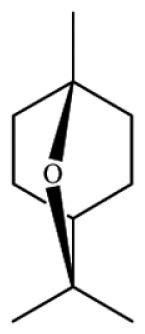 |
Antioxidation |
| Neuroprotection | |||
| 1-Octanol | Anti-inflammation | ||
| Borneol | 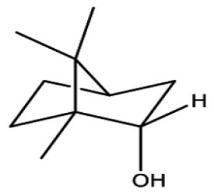 |
Anti-inflammation | |
| Antioxidation | |||
| Neuroprotection | |||
| Bornyl acetate | 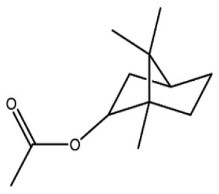 |
Anti-inflammation | |
| Cymene | 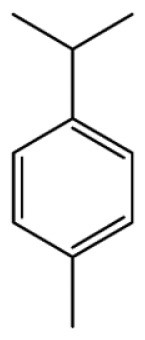 |
Anti-inflammation | |
| Anti-cancer | |||
| Neuroprotection | |||
| Limonene | 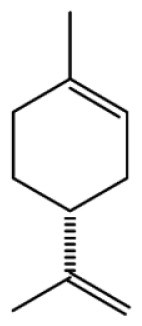 |
Anti-inflammation | |
| Antioxidation | |||
| Anti-cancer | |||
| Linalool |  |
Anti-inflammation | |
| Myrcene | 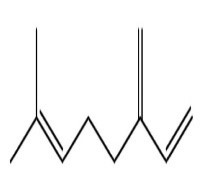 |
Anti-inflammation | |
| Anti-cancer | |||
| Perillyl alcohol | 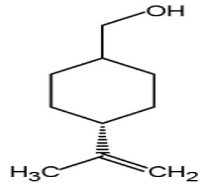 |
Anti-cancer | |
| Pinene | 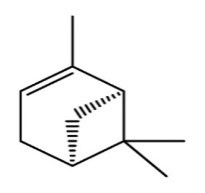 |
Anti-inflammation | |
| Anti-cancer | |||
| Antioxidation | |||
| Neuroprotection | |||
| Sabinene | 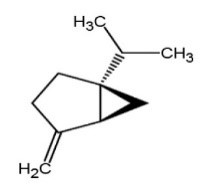 |
Anti-inflammation | |
| Terpinene | 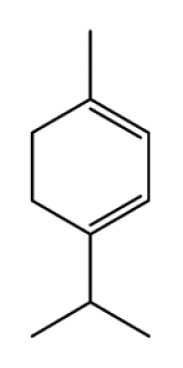 |
Anti-inflammation | |
| Sesqui- | Caryophyllene | 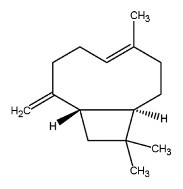 |
Anti-inflammation |
| Anti-cancer | |||
| Antioxidation | |||
| Neuroprotection |
So far, many studies have extensively reported the pharmaceutical activities of monoterpenes among the terpenes. Monoterpenes, formed from the coupling of two isoprene units (C10), are the major molecules consisting of 90% of the essential oils. However, in recent years, small subgroups of other terpenes and terpenoids that exhibit diverse biological activities have been isolated or synthesized, providing a source of novel chemotherapeutic molecules. The use of various terpenes in clinical trials is currently limited due to insufficient data from human studies. However, their use as potent chemotherapeutic compounds alone, as well as in combination with previously proven chemotherapeutic drugs, to increase effectiveness and decrease doses is expected to increase as data on their safety and efficacy in in vivo and in vitro systems are accumulated.
This research was supported by the National Research Foundation of Korea (NRF) funded by the Ministry of Science, ICT and Future Planning (NRF-2016M3C1B6928005).
| BCP | β-caryophyllene |
| GPP | geranyl pyrophosphate |
| DMAPP | dimethylallyl pyrophosphate |
| IPP | isopentenyl pyrophosphate |
| MAPK | mitogen-activated protein kinase |
| NF-κB | nuclear factor kappa B |
| IL | interleukin |
| TNF-α | tumor necrosis factor-α |
| NO | nitric oxide |
| LPS | lipopolysaccharide |
| MMP | matrix metalloproteinases |
| AD | Alzheimer’s disease |
| PD | Parkinson’s disease |